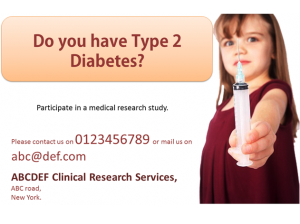A clinical trial enrols human volunteers to determine the safety and efficacy of the new or existing drugs or medical devices in different therapeutic conditions, while the subjects well-being and rights are protected. The success of a clinical research project depends upon the subject enrolment and randomization rate. To accelerate and enhance the patient enrolment, certain methods can be adopted, of which, advertising plays an important role in subject recruitment. All advertisements shall be reviewed and approved by the ethics committee before they are made public. Advertisements can be done through newspapers, pamphlets, e-media, etc.
FDA has set some guidelines for advertising the clinical trials for patient recruitment. FDA states that an Institutional Review Board (IRB) is responsible for review and have authority to approve, require modifications in, or disapprove all research activities covered by the IRB regulations [21 CFR 56.109(a)]. It is the Institutional Review Board’s responsibility to review the content in the advertisement and approve it for patient recruitment.
The following elements should be included in an advertisement as per FDA requirements:
- The name and address of the clinical investigator and/or research facility;
- The condition under study and/or the purpose of the research;
- Brief information about the criteria that will be used to determine eligibility for the study;
- A brief list of participation benefits, if any (e.g., a no-cost health examination);
- The time or other commitment required of the subjects; and
- The location of the research and the person or office to contact for further information.
No claims should be made under any circumstances, intentionally or un-intentionally that the drug, biologic or device is safe or effective or known to be equivalent or superior to the existing one. In advertisements, the words like “new treatment”, “new drug”, “new medication” or “free medical treatment” should not be used as these misleads the public that they would receive a new and improvised treatment to the existing one. However, the trial compensation details can be included in the advertisements.
The IRB should review the content of the advertisement and assure that the information contained in the advertisement and the mode of its communication is not coercive and does not state or imply a favourable outcome or benefit out of the proposed study. The IRB should also review the size, visual effects and the format of the advertisement and the content of the advertisements in case of audio/video advertisements. No advertisement shall be communicated until the IRB approves the final version of the advertisements.
The advertisement, in any mode of communication, should reflect the content of protocol and informed consent. Sample advertisements can be found below.
1. Video Advertisement:
2. Poster Advertisement:


